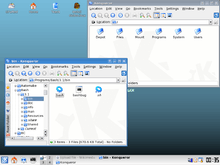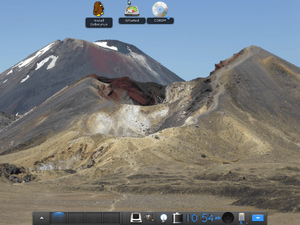GoboLinux
|
GoboLinux desktop | |
| OS family | Unix-like |
|---|---|
| Working state | Current[1] |
| Source model | Open source |
| Initial release | 2003 |
| Latest release | 015 / May 7, 2014 |
| Available in | German, English, Hungarian, Portuguese, Spanish |
| Platforms | i686 and x86_64 |
| Kernel type | Monolithic ( Linux) |
| Default user interface | Enlightenment |
| License | GNU General Public License |
| Official website |
gobolinux |
GoboLinux is an open source operating system whose most prominent feature is a reorganization of the traditional Linux file system. Rather than following the Filesystem Hierarchy Standard like most Unix-like systems, each program in a GoboLinux system has its own subdirectory tree, where all of its files (including settings specific for that program) may be found. Thus, a program "Foo" has all of its specific files and libraries in /Programs/Foo. According to the GoboLinux developers, this results in a cleaner system.[2]
Overview
The GoboLinux hierarchy represents a radical departure from the filesystem hierarchy traditionally employed by most UNIX-like operating systems where specific types of files are stored together in common standard subdirectories (such as /bin for executables and /etc for configuration files) and where package managers are used to keep track of what file belongs to which program. In GoboLinux, files from each program are placed under their respective program's own dedicated subdirectory. The makers of GoboLinux have said that "the filesystem is the package manager", and the GoboLinux package system uses the filesystem itself as a package database.[3] This is said to produce a more straightforward, less cluttered directory tree. GoboLinux uses symlinks and an optional kernel module called GoboHide to achieve all this while maintaining full compatibility with the traditional Linux filesystem hierarchy.
The creators of GoboLinux have stated that their design has other "modernisms", such as the removal of some distinctions between similar traditional directories (such as the locations of executables /bin, /usr/bin, and /usr/local/bin). GoboLinux designers have claimed that this results in shell scripts breaking less often than with other Linux distributions. GoboLinux also allows the user to have different versions of the same program installed concurrently (and even run them concurrently). Furthermore, it has been claimed that the package management index could never become unsynchronized with the filesystem, because references to nonexistent files simply become broken links, and thus become inactive. GoboLinux's filesystem changes also allow other innovations, such as an entirely new boot system that does not use System V or BSD style init systems.
File hierarchy

The design of GoboLinux was influenced by earlier systems such as NeXTSTEP, AtheOS, and BeOS, all of which adopted original filesystem structures while still maintaining a considerable degree of compatibility with Unix. At the root of the GoboLinux tree, there are six directories: Programs, Users, System, Files, Mount, and Depot. The contents of each are described below.
- /Programs/ - This directory contains one directory for each program installed in the system. Each program's directory, in turn, contains one or more version directories, and, optionally, Settings and Variable subdirectories. Examples of paths under programs are
/Programs/Bash/3.0/bin/bashand/Programs/Xorg-Server/Settings/X11/xorg.conf. - /Users/ - This directory contains each user's home directory; a user "harley" has
/Users/harleyas a home directory. - /System/ - Crucial system files. Most are managed by system applications (for example,
/System/Settings/passwd) and GoboLinux scripts (for example,/System/Index).- /Index/ - The filesystem index: contains directories with symbolic links to files from
/Programsentries, such as:- bin/ - Contains links to files from each program's
bindirectories. - include/ - This directory contains links to files from each program's
includedirectory. - lib/ - Links to files from each program's
libdirectory. - share/ - Links to files from each program's
sharedirectory.
- bin/ - Contains links to files from each program's
- Environment/ - Links to environment files. These are compiled into a Cache file and loaded by the shell, allowing each program to register its own environment variables.
- Tasks/ - Links to each program's boot tasks from its
Resources/Tasksdirectory. - Settings/ - Configuration files and links to files from each program's
Settingsdirectory.- BootScripts/ - Scripts used during system boot. This is a symlink to the directory
Settings/BootScriptsunder/Programs/BootScripts.
- BootScripts/ - Scripts used during system boot. This is a symlink to the directory
- Variable/ - Multi-purpose log, temporary, transient and spool files.
- tmp/ - Temporary files.
- Kernel/ - Kernel-related directories.
- Boot/ - Programs and configuration files used during operating system bootstrap. This is where the kernel image and bootloader configuration files are located.
- Devices/ - Device files (managed by Udev).
- Modules/ - Contains the various kernel modules, organized by the kernel release.
- Objects/ - Provides a view of the kernel's device tree (introduced with the sysfs filesystem in the kernel 2.6 series).
- Status/ - Kernel status files (managed by the
procfilesystem ).
- /Index/ - The filesystem index: contains directories with symbolic links to files from
- /Files/ - Files hold structured data that are used by programs but that are not part of the programs themselves. Those files are usually stand-alone entities like fonts, codecs, and plugins (and as such, supposedly do not require package management). Additionally, each program may define subdirectories of its own to store site-specific data; for instance, Compile (the GoboLinux package compilation front-end tool) does this.
- /Mount/ - mounting point for additional local or remote filesystems. Common subdirectories are CD-ROM, Floppy and Zip.
- /Depot/ - repository for a user's files. This repository is meant to be organized as the user sees fit. No subdirectories of
/Depotare considered part of the standard GoboLinux hierarchy.
"Compile" program
Compile is a program that downloads, unpacks, compiles source code tarballs, and installs the resulting executable code, all with a single command (such as Compile foo) using simple compilation scripts known as "recipes".[4]
The Compile system is somewhat similar to Gentoo's Portage system,[5] which is based on the FreeBSD Ports collection. However, Portage is made for a traditional filesystem hierarchy, compatible with the Filesystem Hierarchy Standard, while Compile extends the capability of GoboLinux's distinctive filesystem hierarchy into the area of package management. Thus, in GoboLinux, the filesystem itself serves naturally as a kind of package manager database.[6]
The Compile program was introduced in GoboLinux version 011. Before that, there were discussions about porting Gentoo's Portage system to GoboLinux and developing the port as a SourceForge.net project under the name GoboPortage.[7][8]
Compile's other features included:
- The use of each program's own download site
- The distribution's repository (or one of its mirrors) is only used for downloading recipes. Recipes may be downloaded on-the-fly or in batch.
- Minimalistic and declarative-oriented compilation scripts
- Typical "configure; make; make install" software may be scripted in two lines, greatly easing maintenance.
- Support of GoboLinux-style dependencies
- Software compiled "by hand" by the user is taken into account by a detection mechanism.
- Path-agnosticism
- It also works in a rootless GoboLinux installation (that is, inside a home directory of any other distribution).[9]
Differences from traditional distributions
File hierarchy
In the GoboLinux hierarchy, files are grouped into functional categories in an index-like structure using symbolic links, rooted at /System/Index: All executables are accessible under /System/Index/bin, all libraries are accessible under /System/Index/lib, and so on.
This eliminates many traditional distinctions in the Filesystem Hierarchy Standard, such as the distinction made between non-essential files stored in /usr and essential, emergency files stored directly in subdirectories of the root directory. The GoboLinux developers have maintained that, although these distinctions were once very useful, they are no longer necessary under GoboLinux's schema.
Symlinks
There are symbolic links relating most of the usual Unix directories to the GoboLinux tree. Therefore, one can find directories such as /etc, /var/log, and /usr/bin in the expected places. These symbolic links point to the functional equivalent in the /System/Index tree; thus, traditionally crucial path names (such as /bin/sh and /etc/passwd) are resolved correctly. These compatibility directories are concealed from view using a custom kernel modification called GoboHide, which implements support for hidden files in Linux; it is used for aesthetic reasons only and is thus an optional feature.
Boot system
GoboLinux uses its own initialization procedure, unlike most Linux distributions which use a BSD or a System V procedure. At /System/Settings/BootScripts are a few files that command the entire boot procedure: BootUp and Shutdown run at system boot and shutdown, respectively; additionally, it is possible to define "runlevel" scripts to specify different ways the system may be initialized (for example, Single for single-user, Multi for multi-user, Graphical for boot into graphic mode, and so on); this can be controlled from the boot loader menu. The /System/Settings/BootOptions file separates site-specific settings from the rest of the scripts. Application-specific tasks can be found at /System/Tasks; they can be called by the boot scripts.
Releases
Releases have been numbered using the octal base system. According to the authors, this scheme was chosen because it keeps the typical leading zero that is present in many free software version numbers (since a leading zero often indicates that a number is octal), and it is a play on the "version numbers race" that happened among Linux distributions around 1999. When read as decimal numbers, using octal numbers causes a deterministic "version bump" each eight releases. Up to version 013, GoboLinux made no "point releases", in order to avoid the implication that some releases were more stable than others. This tradition was broken with version 014.01, an update of 014 focused on bug fixes.
- 015 - May 7, 2014: Introduces the /System/Index hierarchy. Linux kernel version 3.14.2, Enlightenment 18 desktop.
- 015-beta - March 4, 2014
- 015-alpha - January 21, 2014
- 014.01[10] - March 30, 2008: Updates of 014, featuring bug fixes and some package updates.
- 014 - December 31, 2007: Features package updates, bug fixes and new versions of the GoboLinux management tools.
- 013 - November 2, 2006: Introduces Listener, a tool for listening on filesystem events and assigning actions to be performed automatically.
- 012 - June 6, 2005: Introduces Manager, a graphical system management tool.
- 011 - June 7, 2004: Introduces Compile, the GoboLinux package compilation tool.
- 010 - January 7, 2004: Adds a graphical installer accessible through the live CD desktop environment.
- 007 - October 22, 2003: Adds a per-package metadata directory called
Resources. - 006 - May 9, 2003: Introduces GoboHide, and adopts a sandboxed installation of programs.
- 005 - 2003: Introduces GoboLinux to the world.
- Releases prior to version 005 were used by the initial group of developers only.
Ports
Gobolinux has been officially made for the i686 only, and the porting to i386 remains incomplete. Ports have been made to embedded architectures, such as ARM and SuperH; these tasks were easily achieved with Bootstrap,[11] a tool developed especially to automate making ports.
References
- ↑ Distrowatch (2014-03-05). "Project status listed as Active as of Wednesday 5 March 2014 06:13 GMT". Retrieved 2014-03-10.
- ↑ Hisham Muhammad (May 9, 2003). "The Unix tree rethought: an introduction to GoboLinux". Retrieved 2008-03-17.
- ↑ Marc Weinem (2008-03-13). "Simplified package management on GoboLinux - an interview with Lucas Villa Real". Retrieved 2008-03-31.
- ↑ Mayank Sharma (2007-02-14). "GoboLinux's recipe for delicious package management". Linux.com. Retrieved 2009-07-19.
- ↑ "GoboLinux Compile -- A Scalable Portage ?". Slashdot. 2004-06-05. Retrieved 2009-07-19.
- ↑ "The Ideas Behind Compile". GoboLinux. Retrieved 2009-07-19.
- ↑ Gentoo Forums : View topic - GoboGentoo
- ↑ SourceForge.net: GoboPortage
- ↑ Mayank Sharma (2007-08-21). "GoboLinux: An Interview with Lucas Villa Real". Retrieved 2008-03-31.
- ↑ Thom Holwerda (April 4, 2008). "GoboLinux 014.01 Released". Retrieved 2008-04-04.
- ↑ GoboLinux Embedded
